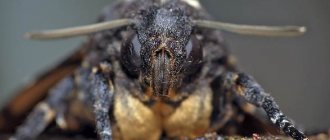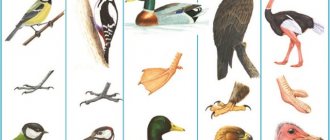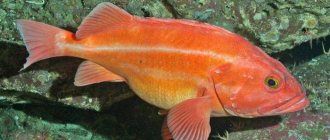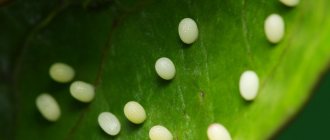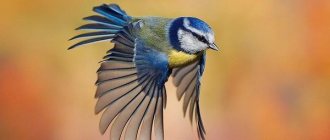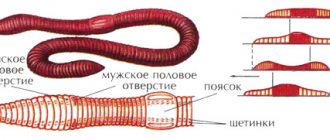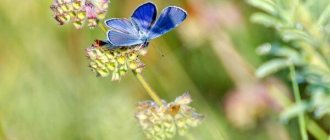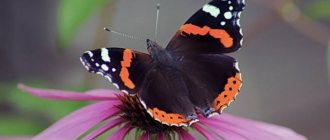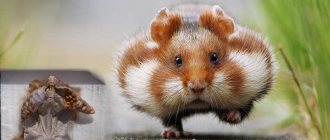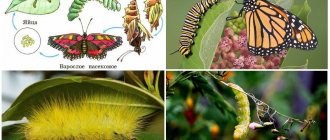- Reports
- Insects
- Butterflies
Butterflies amaze the eye with their beauty and surprise with their fragility. These winged insects are very similar to bright flowers. They can be seen in the summer, when they flutter carefree on warm days and fly past us.
The body of butterflies is light, thin, and has an oblong appearance. Consists of the sternum and belly. Three legs branch off from each abdomen; in total, the butterfly has 6 legs. The head is large and symmetrical. The eyes are very large. There are two antennae and a trunk through which sweet nectar enters the body. At the moment of feeding, the trunk has a straight shape, and at the moment the eating stops, it curls into a spiral.
The wings have a fragile and brittle structure, and if you simply touch them with your hand, you can even damage them. It is not recommended to pick up butterflies. Having damaged its wings, the insect will practically not be able to fly and get food for itself, as a result of which it will die. The range of wing colors is not limited; you can find completely different colors - from white to dark and blue. The drawing can also be of any shape, or even absent altogether.
The main life activity of butterflies takes place during the day, but at night they prefer to sleep. There are certain species of these insects that come to life at night. They are less bright and beautiful than daytime ones.
Life expectancy is very short. But no less amazing. Adult butterflies lay their offspring in the form of eggs on the leaves of trees or plants. As time passes, the caterpillar hatches. She eats a lot, as she has strong jaws and sharp teeth. The main task of the caterpillar is to feed on leaves and gain strength so that it can later turn into a caterpillar. When the time comes for transformation, the caterpillar is covered with a cocoon. After a couple of weeks, a beautiful butterfly is born. During this time, the caterpillar undergoes great changes: legs, a proboscis, and a mustache grow.
The life of a butterfly is very short: from several days to a week. In such a short period of time, you need to have time to lay offspring.
Orders of insects
There are many orders of insects. Their characteristic features are the type of development, the structure of the wings and mouthparts. Some are united by the ability to transform from a single-celled organism into a full-fledged adult being, that is, indirect development.
Main orders of insects:
- Orthoptera;
- Lepidoptera;
- Diptera;
- beetles;
- Hymenoptera;
- dragonflies;
- bedbugs;
- mayflies.
All orders of insects go through up to 4 stages of development. Moreover, at the first stages, the appearance of the insect has absolutely no resemblance to the adult individual. Development from a simple cell to an adult lasts from several days to months and even years.
Order of butterflies, or Lepidoptera
Lepidoptera are the largest group of insects from the phylum arthropods. A characteristic feature of all representatives of the order of butterflies is the scaly multi-colored cover of the body and wings. These scales are nothing more than modified hairs. They have different colors and can create complex and bizarre patterns. These patterns serve as camouflage, hiding the insect or signaling inedibility. For most species, patterns on the wings are of an identifying nature so that individuals of the same species can recognize each other.
Another identifying feature of the order of butterflies is the sucking mouthparts in the form of a long tubular proboscis. To eat, the butterfly extends its long proboscis, plunges it deep into the flower and sucks up the nectar.
The main source of food for the order of butterflies is the nectar of flowers, so they are considered the main pollinators of flowering plants. There is an opinion that with the advent of flowers on Earth, butterflies appeared.
General information
Butterflies belong to the order Lepidoptera, arthropod insects. According to the ancient beliefs of the Slavs, they personify the souls of deceased ancestors, so the attitude towards them should be respectful. This is the most attractive insect in the world. Outwardly, they look like real flowers. The brightness of the color and the whimsicality of their wings is truly fabulous.
To write a report or message about butterflies for 7th grade students, it is recommended to use materials from various information sources. You are allowed to download presentation slides on the topic from the Internet.
Recommended outline of the report:
- External structure of an insect.
- Reproduction and stages of development.
- Main groups.
- Benefit and harm.
For comparison, you can prepare a report on insects with a complete transformation from the blood-sucking order, which become wingless at the imago stage. A 7th grade presentation about fleas or cockroaches is perfect for this.
External structure
Adult individuals differ from other representatives of the order in the special scaly cover of their wings and the structure of their mouthparts, therefore, first of all, in the 7th grade biology project “Butterflies” it is necessary to disassemble the external structure of the insect:
- the head has a round or oval shape, connected by the occipital part to the chest;
- The chest is divided into 3 segments. The front part is significantly smaller than the middle or back part;
- paws or legs - 3 pairs are located in the back. There are spurs on the shins of the front legs. They are designed to keep the insect's antennae clean;
- abdomen - shaped like an elongated cylinder, consisting of 10 segments and having a ring-shaped structure;
- wings - consist of two pairs. They have the structure of a membrane, which is penetrated by longitudinal and transverse veins. They are covered with flat scales of various shapes. They are modified hairs. Some are equipped with a pigment substance - these are colored scales; some are simply colorless or optical. It is their combination in sunlight that gives the amazing effect of metallic shine. The dimensions of the front and rear wings can be the same or differ in size and shape. The bizarre coloration serves not only as decoration, but also as a protective camouflage, with the help of which the insect is perfectly camouflaged, blending into its surroundings.
The body of the butterfly is protected by a durable chitinous shell. Depending on the species, the size of the insect varies from 2 mm to 31 cm.
Vision, smell, hearing
In addition to the external structure, 7th grade students are advised to pay attention to the structure and functioning of other important organs of the insect in a biology presentation about butterflies.
Organs of an adult:
- The oral apparatus is a proboscis twisted into a spiral. It is formed from unconnected lower jaws, or rather, their blades. Depending on the species, it may be of the gnawing or sucking type.
- The eyes are large, hemispherical, of complex structure, consisting of many facets, each of which resembles a miniature eye individually. They come in brown, red, yellow, orange or white. The butterfly's eyes occupy a large area of the head. Color vision. The butterfly clearly sees only moving objects, and perceives motionless ones much worse. Some representatives have additional eyes that are located behind the antennae. They are called parietal.
- The antennae are located on the border of the frontal and parietal parts. Their structure and length depend on the type of insect. Thanks to the antennae, the butterfly is perfectly oriented in space, distinguishes odors, and detects even the slightest fluctuation in the wind.
Butterflies have excellent hearing. They are able to detect even barely noticeable ultrasound. The sense of smell works great. And the sense of taste is so developed that they are able to sense even a very weak concentration of sugar. These organs are 2 thousand times more efficient than human organs. Butterflies can also taste food not only with their proboscis, but even with their paws.
Types of representatives
Science knows about 158 thousand representatives of various species of butterflies. Only runaways, this is one of the subspecies, is divided into several types, differing in appearance by a number of other features:
- Cabbage butterfly. A butterfly, the males of which are white with black dots, the females are bright yellow. The size is about 65 mm. They feed on plants.
- Lemongrass. The representative of this species is yellow in color, and the female is white-green. They are united by a red circle located in the center. The wings are made in a very unusual way, with imitation ends cut off with scissors. Its size is about 55 mm.
- White pea. An endangered species of the family. The outer sides of the wings are colored white and gray, while the inner sides are green, allowing her to blend in with the grass.
- Turnip white. It is similar to the cabbage butterfly, but differs in size, which is about 45 mm, and in the number of black spots on the wings. The male has 1 spot, and the female has 2.
- Greenfinch. It has a white color with dark spots and a green pattern; it feeds on cruciferous vegetables, in which it lays its eggs.
- White rapeseed. It is white in color with a yellow pattern and clearly visible veins. Is migratory. For the winter it flies to warmer climes, namely North Africa.
- Alpine whiteweed. It has a white-gray color. In males, the ends of the wings are painted black with white splashes.
- White euphema. It is white with a yellow tint and has a dark spot in the center. The lower wings are decorated with a green pattern. It is a steppe inhabitant.
- Hawthorn. The butterfly is white with clearly visible black veins. Its size is about 60 mm.
Cocoonworm family
Insects belonging to this family are large or medium in size with a large body that is covered with hairs. They are more like moths, their antennae have bristles, and their front wings are much larger than their hind wings. The main representatives include:
- The Siberian is medium in size, yellow-brown in color with a white spot in the center, but the color of the wings can vary from individual to individual and can be black. Uses tree needles for food and egg laying.
- Ringed. The size is about 40 mm. It has a yellow-brown color on the front wings with two dark stripes. The hind wings are a lighter color without stripes. It lays its eggs in the form of a ring, which is how it got its name. It is a tree pest.
- Pine. The butterfly is large (about 80 mm) with a color that resembles pine bark. Flies in the second half of July. Lives in pine forests.
They usually live in groups in trees. Some members of this family are pests.
Blueberry family
Five thousand species of this family are known in nature, some of which are on the verge of extinction and are listed in the Red Book. They are medium in size and bright in color, but depending on the species, the color may vary. A distinctive feature of bluebirds is the colored pattern on the lower wings in the form of eyes. They are not pests; on the contrary, they are beneficial in the form of repelling insect pests.
Bright pieds
Includes about 1,200 species, most of which live in the tropics. They range in size from medium to large and are brightly colored with a rainbow pattern. It is needed to warn that the insect is poisonous, and if life is threatened, it will defend itself by secreting a poisonous liquid that has a pungent odor. Among the main representatives are :
- Admiral. It has an average size of about 55 mm with a velvety surface and a bright color of white spots with a red stripe.
- Peacock eye. A large butterfly, up to 150 mm in size, with a bright red-brown color with an eye pattern at the corners of the wings. This pattern protects the insect by scaring away enemies.
- Swallowtail. An endangered species of butterfly. A multi-colored species of insects, with tails on the lower wings, the most attractive are swallowtails with a yellow color and black spots and veins.
It prefers the leaves of legumes as food, which is a distinctive characteristic.
Reproduction and development stages
During the mating season, some species of butterflies use a complex courtship system, which is expressed in mating dances and special flights. The mating process itself can last for several hours. During the transfer of sperm, the female receives the necessary complex of microelements, proteins and nutrients.
Stages of development:
- Eggs - the female lays them on the leaves or branches of various plants. At this stage it has a cylindrical or round shape. One clutch can consist of 1 thousand or more fertilized eggs. The future butterfly remains in this stage for 8 to 15 days, after which it transforms.
- The caterpillar feeds on plant foods. After birth he has an excellent appetite. This is due to the complex structure of the body. Now it represents a whole system consisting of 2 thousand muscles. The caterpillar is capable of secreting a specific substance that hardens when interacting with air. As a result, a transparent silk thread is formed. Subsequently, it becomes a strong cocoon. While in this stage, the caterpillar molts about 5 times.
- The pupa is the next life cycle. Pupation occurs gradually, during the process of wrapping the caterpillar in silk thread. The process of a butterfly developing inside a cocoon is called metamorphosis.
- Imago is an adult butterfly.
After the cocoon has cracked, the formed butterfly spreads its wings. Hemolymph begins to spread through the veins, thanks to which they harden and turn into a strong support.
Interesting facts about Butterflies
Butterflies appeared on Earth even before humans. They are unique creatures, the second largest pollinators after bees. The science that studies butterflies is lepidopterology.
Let's present the most interesting facts from the life of butterflies that few people know about:
– Not all butterflies sit on food; they can only fly nearby and feed on food through their proboscis. However, they can only recognize taste with the help of their legs, since this is where special sensors are located.
– In a day, butterflies can pollinate more than a thousand different plants. This is a huge figure, and therefore these insects are the second largest pollinators after bees.
– These insect representatives have a rather peculiar breathing: air enters the air sacs through special spiracles located on the butterfly’s stomach.
– The antennae on the head of a butterfly are organs of smell; they help insects at a great distance to find the necessary food or find a female.
– Butterflies are myopic insects. At the same time, their eyes include six thousand different lenses and peepholes, which, however, are capable of distinguishing not all colors. These insects can distinguish only three colors: red, yellow and green, including their various shades.
– Butterflies have an unusual circulatory system. Blood circulation occurs not through the heart and blood vessels, but through a container that is located on the belly and connected to the butterfly’s head using a small tube.
– During the breeding season, the female insect secretes a special substance, the so-called attractate, which attracts males. And although very little of it is released, this does not prevent males from smelling it several kilometers away and flying to the female.
– The life of a butterfly is a cycle consisting of several stages. At the first stage, the egg appears, then it turns into a caterpillar, then comes the pupa and the last stage is the adult.
– The skeleton of this insect is built in a special unique way. It prevents the possibility of injury and always maintains the desired level of humidity.
– A butterfly has a very short life. Typically, butterflies only live a few days on average. However, during this short period they manage to lay about one thousand eggs.
The butterfly is one of the most beautiful insects.
Main groups of butterflies
All types are conditionally divided into 2 groups. These are day and night representatives:
- White-whiskered or day-whiskered - a distinctive feature is the white antennae ending in a noticeable thickening. Their flight is fluttering and slow. This is explained by the structure of the wings. The hind wing along the leading edge of this group is noticeably enlarged, so during flight both wings work as a single unit. The period of activity of white-whiskered butterflies occurs during the daytime. Their body has a slender outline, and their wings are usually brightly colored. When at rest, they fold them vertically, raising them above their body.
- Variegated or nocturnal - have combed or feathery antennae. Activity time: night, twilight. The flight is frequent and rapid. When at rest, the wings are spread apart or folded into a “house”. The coloring is most often discreet, the physique is dense.
Both groups of insects can bring both benefit to humans and great harm.
Night and day species of butterflies
Nocturnal butterflies differ from day butterflies in very few ways. The main difference is that during rest, the night butterfly folds its wings, but the day butterfly does not. Also, the color of the day butterfly is brighter. Its coloring includes blue, red, yellow, and other colors. While most of the moths are gray-black.
Therefore, there is no such criterion as night or day butterflies. Mostly people say this to simplify explanations about who they saw during the day or at night.
Benefits and harms
For agriculture, butterflies bring both benefits and harm. At the caterpillar stage they are undoubtedly pests. At this time, insects are capable of destroying a significant part of the crop, as they feed mainly on the leaves of fruit trees.
In addition, butterflies are dangerous during mass reproduction. To prevent the complete destruction of the crop, gardeners begin to actively fight, usually resorting to various methods.
Adult butterflies bring great benefits by pollinating plants. Particularly prized species are the silkworm, which is capable of producing high-quality silk.
In addition to the topic “Butterflies,” the biology program suggests preparing a presentation about fleas for 7th grade lessons.
Butterfly habitats
In fact, butterflies are distributed throughout the world and live on every continent except Antarctica. They are physically unable to withstand the eternal cold, and in addition to this, there are no plants on the glaciers that could serve them as food.
And yet, scientists were able to find out the location of the largest number of butterfly species - these are the territories of India, its environs and the forests of South Asia. Their habitat primarily depends on climatic conditions. These insects love warmth and humidity, so their accumulation in most cases depends on these two factors.
They are most often found in flowering meadows, fields and forests, because there, not including the cold seasons, it is almost always warm and there is a sufficient number of plants that act as food.
